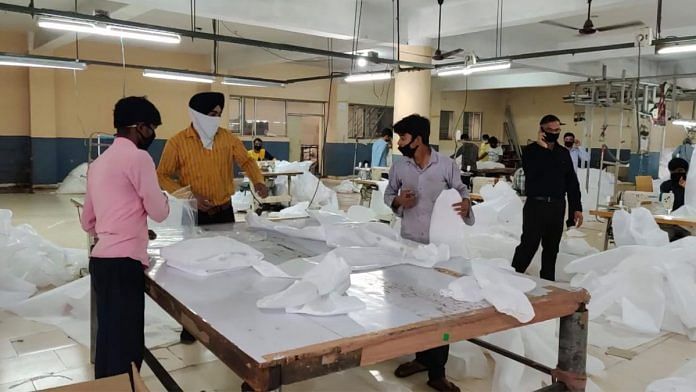New Delhi: Covid-related restrictions hurt the economic activities of states with a higher share of industry and services much more compared to those that rely more on agriculture and mining, shows a study by economists at the Reserve Bank of India (RBI).
In the paper titled ‘Impact of Covid-19 on Economic Activity Across Indian States’, published last Friday in the RBI’s monthly bulletin, authors Sudhanshu Goyal, Akash Kovuri, and Ramesh Golait of the bank’s Department of Economic and Policy Research made the case that policies restricting mobility — lockdowns in this case — do not disrupt agricultural activities as much as they do the industrial and service sectors.
The study’s findings about the pandemic’s “differential impact” on 18 states in two years of the pandemic has highlighted the importance of states devising and deploying their own policies, depending on their respective economic structure, in times of crisis when mobility is affected.
In essence, the authors hinted that one-size-fits-all policies may be detrimental to economic health.
“During such a massive crisis, well-informed and coordinated policy decisions at the national and state level will lead to minimum loss in overall economic activity,” the authors wrote. Recovery, too, would be quicker, they added.
Also read: Why Punjab farmers who bet big on moong this summer reaped a harvest of discontent
How was ‘economic activity’ measured?
To measure the “diverse economic trajectories” of the states, the authors constructed an index comprising various indicators of economic activity, including the Goods and Services Tax (GST), electricity generation, employment rates, exports, the demand for work under the Mahatma Gandhi National Rural Employment Guarantee Act (MGNREGA), and deposits in accounts under the PM Jan Dhan Yojana.
The authors used a two-year time period for the study of these variables — from March 2020 to February 2022 — for 18 states whose data was fully available and which together account for about 93 per cent of India’s GDP.
According to the authors, a positive value of this index implied above-average economic activity, and vice-versa in case of negative index value.
The economic activity index showed that the first and most severe lockdown, launched in April-May 2020, was the hardest time for India’s economic activities.
The average economic activity index score for the 18 states was -2.1 in April 2020, and remained negative until December that year.
When the second wave hit the country in May 2021, the average of the 18 states was positive — just about — at 0.005. However, in this period, the majority of the states were negative except for Bihar, Jharkhand, Chhattisgarh, Maharashtra, Gujarat, and Odisha.
By the time the Omicron variant arrived in January-February 2022, the economic activity index remained positive for all states, implying that they were able to withstand the impact, albeit with varying degrees of success.
In February this year, the average score was 0.8, with Karnataka (1.49), Bihar (1.29), Odisha (1.28), Rajasthan (1.16), Uttar Pradesh (1.09), Jharkhand (0.9) Haryana (0.89) and Gujarat (0.83) scoring above the national average. The states that scored the lowest on the index at this time were Assam (0.26), Kerala (0.34), and Tamil Nadu (0.43).
What this data shows is that prolonged restrictions affected the economic activity of some states more than others. Similarly, while some bounced back quickly despite continuing restrictions, others took longer to regain their footing.
Why did Covid affect states differently?
To understand why Covid-19 restrictions affected states differently, the authors tried to relate “mobility” to the type of economic activity being carried out.
For this, they calculated two things.
One was the amount of mobility, using data from Google’s community mobility reports that charted movement trends in different places over time using different categories of places, like stores, parks, workplaces, and so on. The second was the contribution of different sectors in a state’s income earned.
The analysis showed that the relationship between mobility and agricultural activities was weak. This implies that a mobility restriction policy was less likely to impact agricultural activities. Within agriculture, the impact was lowest for those involved in forestry and logging, the paper said.
Industrial states, according to the report, showed a higher relationship with mobility, implying that higher the restrictions, lower the economic activities. However, this applied most to states that had a greater share of manufacturing activities.
According to the paper, the share of mining and quarrying exhibited a low relationship with mobility, and so a restrictive policy was less likely to impact this set of industries.
In the case of the services sector, the data showed that mobility restrictions had the highest impact on states with “more dependence on contact-intensive services”, like trade, hotels, and transport.
The analysis, according to the authors, could be used the next time India has to resort to emergency measures that include mobility restrictions.
“Such granular analysis at sub-sectoral level and of economic structure has emphasised the need and importance to have a differential policy response by the states based on their respective economic structure supplementing the national policy interventions,” the authors wrote. This, they added, would allow the “wheels of economic development” to “recover swiftly after major economic disruptions”.
This analysis represents the personal views of the economists and are not to be taken as an official RBI statement.
(Edited by Asavari Singh)
Also read: ‘Price of defending rupee’: Sliding by $3.6 bn/week, India’s forex sees steepest fall in decade



